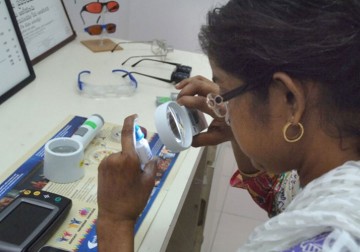Dr. Vijaya Gothwal and Sujata Sharma from the Meera and L B Deshpande Centre for Sight Enhancement, L V Prasad Eye Institute investigated the abandonment rates of Low Vision Devices and the factors that led to the abandonment at a tertiary eye care center using a self-reported questionnaire. The study reports abandonment rates comparable to that found in high-income countries like the USA or the UK.
Low vision devices (LVDs) improve the independence of people with vision impairment that cannot be corrected with conventional glasses or surgery. LVDs enhance their ability to function resulting in a better Quality of Life (QoL). For instance, optical or electronic magnifiers for near use can assist individuals with low vision to read books, newspapers, or other text. These devices can be hand-held or stand magnifiers, or electronic devices like portable or desktop video magnifiers. There is evidence to show that low vision rehabilitation programs that include prescription and training in the use of LVDs, along with other interventions, are effective at improving the QoL of the vision impaired adults and children.
Despite such benefits, a significant portion of LVDs prescribed are unused or often abandoned. Some of the common reasons for abandonment include social stigma, a lack of need in older adults, inadequate magnification, or even poor ergonomics. Surveys in high-income countries like the USA and the UK report abandonment rates of 8-20%. In low- and middle-income countries (LMICs)—where 90% of people with vision impairment live—only about 5-10% have access to low vision rehabilitation services. Under these circumstances, each abandoned low vision device represents a huge opportunity cost. However, abandonment rates in LMICs are unknown. It is therefore important to understand abandonment rates, and the reasons for non-use and abandonment in LMICs like India.
A new, first-of-its-kind study by Dr. Vijaya Gothwal and Sujata Sharma published in the Ophthalmic & Physiological Optics addresses this gap. The study investigates the rates of abandonment of low vision devices for near use and the factors impacting abandonment in patients presenting to the Institute for Vision Rehabilitation at a tertiary eye care centre in South India. 286 individuals with low vision completed the 'modified’ abandonment survey one year after prescription of the devices. The survey had 6 questions on device possession, usage history, abandonment and QoL. 312 devices were prescribed to 286 individuals at the centre. One year later, the survey found that 64 people (22%) had abandoned at least one device—and 57 (89%) recorded the reasons for abandonment.
30% of those who abandoned their device found it to be ‘too cumbersome to use’ or had other device-related issues. Another 26% found the devices complex and frustrating, while 19% reported changed vision. Older patients were more likely to abandon their device. Most patients who reported no change in QoL due to device use were also more likely to abandon it. It is encouraging to note that most people (about 78% in this study) with low vision use their magnifiers over time. The study’s findings point to the need to improve LVD design and to develop strategies to reduce abandonment.
‘Patients reporting no change in their quality of life had higher odds of device abandonment compared with those reporting some change,’ notes Dr Vijaya Gothwal, Head, Outcomes Research unit and Senior Faculty, at the Bausch & Lomb School of Optometry, LVPEI. ‘Clinicians can use the results from this important study to develop strategies to improve compliance with use of near-vision devices.’
Citation
Gothwal VK, Sharma S. What are the reasons for abandonment of low vision devices prescribed in a large tertiary eye care centre? Ophthalmic Physiol Opt. 2022;00:1–8. https://doi/10.1111/opo.13055
Photo credit: Photography dept., LVPEI.



